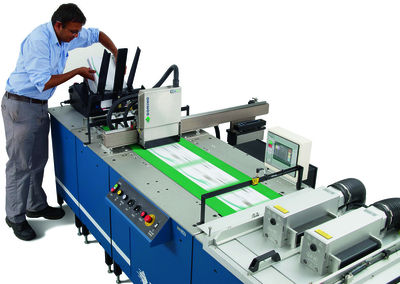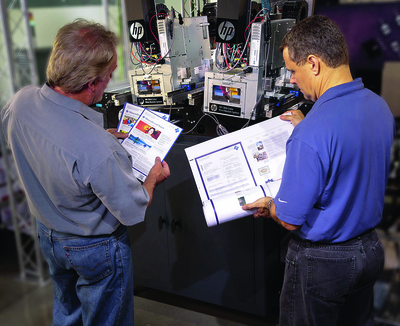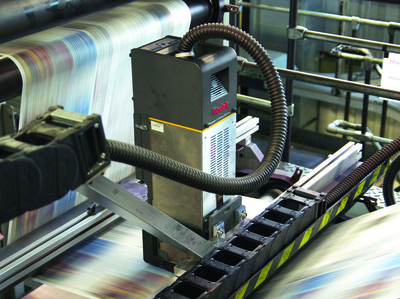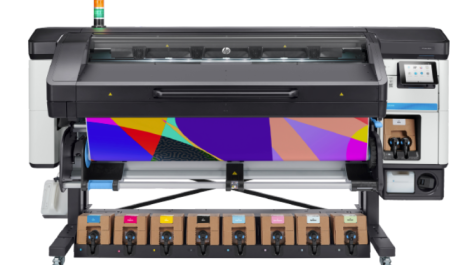A Kodak Prosper S30 imprint unit
A new generation of high resolution inkjet print modules can work on conventional press and finishing lines to give high quality at high speed. Simon Eccles examines their progress so far.
Putting digital print elements onto a ‘conventional’ analogue press to form a hybrid is not a new idea, but at the last drupa it seemed that it was coming into its own with new high resolution head systems capable of 600 dpi, said to be enough to match offset quality. Nearly all the big offset press manufacturers announced that they would be offering inkjet heads to handle variable data.
However, the slowdown in new press sales means that it is not apparent how attractive a proposition this is turning out to be in practise. ‘On presses it’s all retrofitting,’ said Philip Easton, director of digital printing solutions at digital printing systems developer Domino Printing Sciences. ‘There aren’t many new presses being sold. In many cases there’s overcapacity of the conventional presses, so we use the handling systems to give them a new lease of life as digital presses. We can use an existing paper handling system and make it into a variable data printing line. In some cases, we do a complete conversion to digital, so we’re only using it for its transport.’
Domino has been making inkjet modules for more than 30 years, starting with relatively simple continuous inkjet coding and marking units for corrugated outers, and progressing to the sophisticated piezo drop on demand 600 dpi K600i heads that it also uses in its own N600i digital label press.
The K600i is used for a range of applications, especially mounted on flexo webs and narrow web label presses, said Mr Easton: ‘In North America they’re used a lot for 2D codes on labels, especially in the traceability of fresh produce. They are also used for personalisation of tickets.’
Kodak is also a long standing player in this market. Its Versamark continuous inkjet head range, which was widely adopted for direct mail personalisation work, has in recent years been superseded by the Prosper S-series heads, which use a sophisticated new continuous technology called Stream.
Streaming into newspapers
In the past year or so, these have seen some high profile sales to very large newspaper printers with web press lines, including 33 Prosper S30 units to Axel Springer for 13 newspaper sites in Germany, and Newsprint, which installed 22 heads across five sites in the UK and Ireland, where they are initially being used to put unique online-access numbers and QRs onto copies of The Sun and Sun on Sunday.
Anton Group in Basildon has been installing Kodak Prosper S5 heads for several years, first onto Heidelberg Speedmasters and then its newer XL 106 presses as they came in. It is the largest Prosper user in the UK. Chris Chapman, senior account manager, inkjet printing solutions at Kodak UK, says Anton Group now has 34 active heads, including 16 to a pre-print duplex duplex roll-to-sheet Cut Star feeding system on one of its Heidelberg XL 106 sheetfed presses.
‘At Kodak we’ve been in this business for a long time,’ Mr Chapman pointed out. ‘The complexity is high, it’s not just a matter of bolting the heads on. It takes a lot of experience to know how to do it.’ Indeed, Kodak claims that its inkjet experience goes back more than 40 years, though a lot of that was by acquiring other developers.
Mr Chapman added: ‘We’ve also just sold eight heads to Eclipse Colour and will install these on an existing Speedmaster 102 around mid-June. This is for full-width mono simplex personalisation.’ Again the heads will go on a Cut Star sheeter.
Kodak prefers to mount to roll feeders or webs, Mr Chapman said. ‘Sheet fed is different and you really need a reel-to-sheet system as it’s hard to work with a sheet feed and its grippers. On web offset we would typically look for a mounting place after the driers, around the chill unit.’
Colour capability
Manchester based printer Gask & Hawley recently ordered a Goss M-600 heatset web offset press, due for delivery later this summer. It will integrate Kodak Prosper heads after the drier for full colour zoning and personalisation. The Prosper stage is expected to be live by Christmas, according to Goss sales director John Chambers.
Initially the proposal was for black-only inkjet capability but after discussions with customers and visiting sites in the USA, the company decided to go for four-colour from the start. G&H is not mentioning specific customers, but it has a variety of contracts, including supermarkets, that involve regular repeat printing in high volumes, with personalisation and distribution to targeted areas.
‘Although this will be the first such Goss press line in the UK, we are already past masters of setting up this kind of operation in the US, where many web printers have vast distribution areas requiring different treatments,’ said Mr Chambers.
Greg Norris, marketing manager of Goss International, explained the integration process from the press maker’s end: ‘Generally, Kodak, or the supplier of the inkjet technology, provides essentially self-contained controls for operating the inkjet heads and managing the data supplied to them. Goss would integrate that within the overall press controls. Goss would also provide the physical auxiliary tower/structure that the inkjet heads are mounted on.
‘From our perspective, adding the inkjet capability is not so much a time or cost saving advantage, but rather it presents an opportunity to produce a new type of hybrid printed product (some common content and some variable content), with a compelling value or return relative to the cost.
‘In terms of time or output, a printer would likely run a hybrid web press slower than the same press could be run in an offset-only application, with the inkjet heads being the limiting factor (maybe the other in-line finishing processes as well). However, this would still be much faster than the output of a pure digital press. Keep in mind that our customers are doing this on webs up to 1.9 metres wide. The other thing for a printer to consider is that they can bypass the inkjet heads and run the same press at full speed for offset-only jobs.’
This gives something of the best of both worlds, the high speed and economies of scale for offset on long runs, with the flexibility of digital for versioning and personalisation. Mr Norris said: ‘That cost advantage naturally increases as the run lengths go up. The specific costs really depend on the particular job, but the principle is the same, regardless of substrate, ink coverage, etc.’
Kodak is by no means the only inkjet print module developer. HP, Domino, Graph-Tech and Videojet are among the prominent alternatives with years of experience too.
For instance, Domino produces a range of inkjet overprinters, from comparatively simple coding and marking heads for packaging outers, through to the high speed, high res K600i drop-on-demand modules with Kyocera heads. These are also used in the company’s N600i full colour label press and the Graph-Tech MonoCube monochrome book press.
 Domino’s K600i head can be installed over practically any paper transport line
Domino’s K600i head can be installed over practically any paper transport line
‘We’ve sold 130 K600i systems,’ said Mr Easton. ‘They are used for a range of applications, especially mounted on flexo webs and narrow web label presses. In North America they’re used a lot for 2D codes on labels, especially in the traceability of fresh produce. They are also used for personalisation of tickets, and we do a lot of direct mail applications.’
Both Kodak and Domino tend to sell mostly monochrome imprinters, though both can handle colour, as Kodak proved at Anton. Mr Easton at Domino explained why: ‘We’ve stayed away from full colour ourselves because the materials handling is much more complex than for black only, as you have to worry about registration, web tension and web movement from side to side. We’ve put a lot of CIJ and binary inkjets on a lot of systems. But as soon as you need to print higher quality, then you need to worry about the materials handling system.’
Domino owns Graph-Tech, the company that makes the transport system for the full colour N600i, so it can tightly integrate into the control system.
HP, on the other hand, gets around the web control issue in its TIJ4 thermal inkjet printheads by putting all four colours into separate nozzle stripes in the same head. Annette Friskopp, vice president and general manager of HP Specialty Printing Systems, said: ‘With our colour print modules the individual colour printheads are spaced very closely, so you have less colour to colour registration issues, which I understand is the case with some of our competitors if their printheads are spaced up to several feet apart.
‘That’s been one of the key practical selling points to the folks that have to figure out the whole paper path and stability. There’s less to worry about because there is less chance for registration problems.’
The TIJ4 heads are four and a quarter inches wide and their price means that most users want to take advantage of the colour capability. However, Ms Friskopp said that some integrators and users who only need black ink have been using the TIJ4 mono and even the 0.5 inch wide TIJ2.5 heads stitched together in wide arrays.
‘One user has stitched together 16 of them to get an 8-inch page width, and they are doing variable data with that technology,’ she said. ‘They’ve built their own controller and I’m seeing bank statements being personalised in some very interesting developing world applications.’
The HP heads are offered in Colour Print Modules that can be installed as units onto other production lines. Currently these are the C500 (for inserters and mail tables running at up to 152 metres per minute at 600 x 600 dpi) and C800/M800 (for sheetfed or web units running at up to 244 metres per minute at 600 x 600 dpi).
 A pair of HP C800 full colour ptint modules installed on a web line
A pair of HP C800 full colour ptint modules installed on a web line
These are either taken on by OEMs that perform their own integrations and sell them inside their own brands, or they are handled by HP’s approved system integrators, Document Data Solutions in the USA and DJM Inkjet Solutions in Europe, which develop customised installations for cut sheet or web systems.
Pitney Bowes is probably the best known of the OEMs and in recent years has been staging impressive demonstrations of full-colour personalisation of envelopes on its mailing lines.
HP has recently changed its approach to this market, Ms Friskopp explained. ‘We have been in the business of also building controller software to drive the highly custom systems that some of our integrators or customers use. When I stepped into this business at the beginning of this year we reviewed this business and we made an investment choice to wind down the customised controller software. We are exiting the Controller software on a long term basis, and we will continue to sell toolkit software, parts and supplies. This lets our OEMs and integrators continue to do their magic, which is talking to those print modules for their unique applications.’
Three year forecast
Longer term, HP also said it is committed to supplying its current product line for the next three years, though this does not necessarily mean they will be dropped then, Ms Friskopp emphasised. Nevertheless, companies thinking about making a big investment might start to wonder about lifetimes, even more than if HP had said nothing.
To clarify this, Ms Friskopp said: ‘We look at all of our products and from time to time announce the end of life of our products. We have said that we are committed to the current configuration for roughly three more years, and we give assurance that spare parts and supplies will be available for a further five years after that.
‘We’re making a pretty far-reaching commitment that we’re going to continue in this line for the next three years. Customers that we have at that point, we’ll continue to support for an additional five years. Then as part of our normal review processes we’ll look at whether we continue to extend the life of this product line beyond that. The feedback has been so positive that we’ll likely want to continue with this even with new customers beyond three years.’
Doing the Samba
Fujifilm Dimatix has long been a player in this market as a maker of printheads (originally called Spectra heads), though Bailey Smith, director of business development, said that print modules are always built by OEMs, for example Graph-Tech.
He revealed that by the end of this year several OEMs are expected to announce print modules based on the advanced Samba MEMS-based piezo heads, first seen as full-width arrays in the Fuji Jet Press 720 B2 press. “This will take us a step above even the 600 dpi of some of our competitors,’ he said. The Samba heads can achieve 1,200 dpi resolutions if required, or they’ll run at 600 dpi on web speeds that keep pace with the 300+ metres per minute claimed for some Kodak Prosper configurations.
Samba is also notable for the ease of configuring different print widths into wide arrays if needed. The individual print heads are rhomboid shapes, with angled outer edges. This allows them to be butted up side by side with other heads to form a continuous strip array with nozzles that overlap at the margins. More conventional designs are rectangular, so normally a wide array has to place the heads in a staggered forward-backward configuration in order to avoid a blank area at the joins.
‘We are working with early adopters and we’re very excited by the response to Samba,’ Mr Smith said. ‘We hope to see some public announcements soon.’





